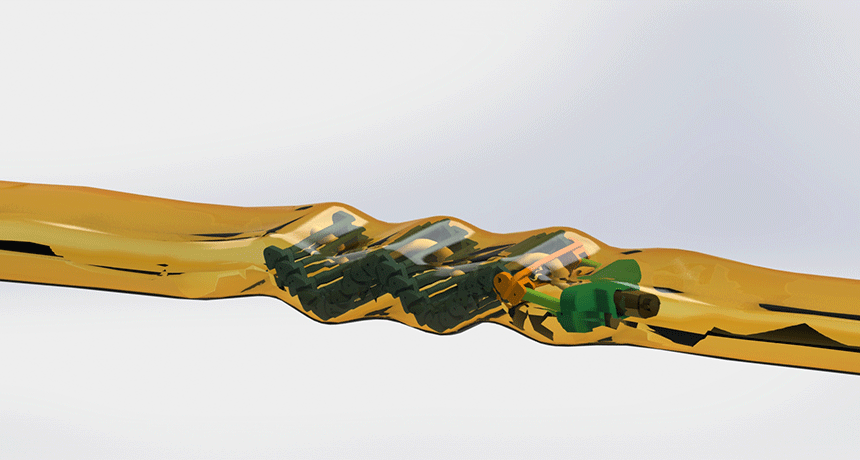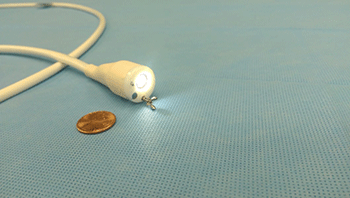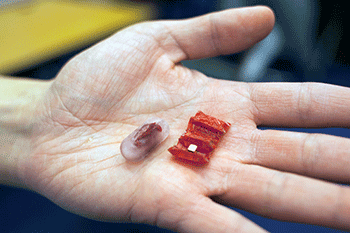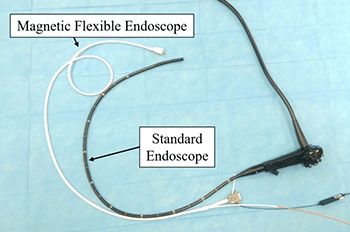Robots may soon actively crawl through your gut
Doctors will guide them to deliver medicine and check the intestines for disease

This illustration shows a robotic device, created by researchers in Israel, crawling through the intestine. The robot, which is about 2.5 centimeters (one inch) long, has a smooth surface so it can move through the stomach and intestines harmlessly.
David Zarrouk, Ben-Gurion University
By Eric Niiler
There’s a wet, squishy tube 9 meters (30 feet) long that carries food from your mouth to your stomach and on through the gut. At times it will get folded over and over (to fit into your belly). This digestive tract is where your body slowly breaks down food, absorbing what it needs for energy and health. Anything not needed will exit out its end — and unceremoniously into your toilet — as waste.
As the entry portal for all food and water, its function and health is pivotal to life. But when symptoms suggest a problem, doctors can find it a tough place to explore.
Certain symptoms that might suggest disease, such as cancer, lurk within its enormous span. Maybe doctors will need to deliver a drug at some precise milepost along the path. They might even need to retrieve something small — such as a penny or battery swallowed by a young child.

Today, to see inside this tube of wet digesting food and wastes, doctors often turn to a tiny video camera. It’s shaped like a pill and about that size. After swallowed, it slides down the throat, into the stomach and on through the intestines. Eventually it will exit out the other end. A doctor can pore over the images it captures throughout its voyage.
But that camera only takes video. It can’t treat disease or retrieve a penny. That’s why doctors are now teaming up with engineers to build tiny robots. One day, these mechanical devices might deliver medicine on demand. Or they might cut out a tiny tissue sample, called a biopsy (BYE-op-see), in which doctors can check for signs of cancer.
Such devices offer to make medical procedures safer and more comfortable. They may also deliver new and better views of the inner you.
Crawling through the colon
Swallow a bite of pizza or spoonful of custard and the digestive tract takes over. By squeezing and releasing, the tube slowly pushes anything you ate or drank down and around the gut. Swallow a pill-like camera and the same thing happens. The body pushes it through the digestive tract. But these new robots aren’t just passive tools along for the ride. They may crawl or wiggle through the body. They can move backward or forward at the command of your doctor.
Once they’re done, these gut crawlers then leave the body just like a regular piece of waste.
David Zarrouk is a professor of mechanical engineering at Ben-Gurion University in Beer-Sheva, Israel. He and his team are building such a robot. It carries a motor to power its worm-like wiggling. Small electronic sensors inside it collect data on the robot’s precise position in the body. A smooth artificial skin lets the robot snake through the stomach and intestines without damaging them.
This worm-bot is known as SAW. That’s short for single-actuator wave robot. An actuator (ACK-shoo-ay-tor) is a part of a machine that makes the entire device move in response to some signal.
Zarrouk has always been interested in building small robots that move in unusual ways. He started working on the worm-like robot in 2015. SAW “will be very smooth and small enough to pass through the body,” he says. It should be able to deliver drugs. And, he notes, “In case it breaks down, it can continue on its own. The digestive system would take it out of the body.”
The Ben-Gurion team is using a 3-D printer to build the robot out of plastic. Eventually they plan to make the robot from special materials that will not irritate human tissue. “We try to use soft surfaces that are not going to cause damage,” Zarrouk explains, “because the intestines are very flexible.”
Zarrouk has already started testing SAW in the intestines of pigs. They were donated by a local cooperative farm, or kibbutz (Kih-BOOTZ). Engineers and computer scientists are now working to shrink the robot’s size, yet keep it powerful enough to perform its job. Zarrouk hopes to be ready to test the device in people sometime later this year. However, he adds, it won’t be ready for widespread use until long after that.
Origami for the gut
While the Israeli team is making robots that crawl through the gut, researchers in Boston, Mass., are at work on a tiny robot that will unfold at its worksite like a mini-umbrella. They believe their device offers the best approach to exploring the digestive system without causing problems or getting stuck.
“It is an origami-style robot,” explains Daniela Rus. She’s a professor of electrical engineering and computer science at the Massachusetts Institute of Technology in Cambridge.
“We can actually squish the robot into the shape and size of a pill,” she says.

The device will be frozen in ice before a patient swallows it. Once warmed in the stomach, the ice will melt. This will cause the robot to unfold and start moving.
The engineers in Rus’ lab would drive this robot with a magnet passed along the outside of the body. They’re currently working with a simulated stomach. The magnet pulls the robot in the direction a doctor wants it to go. Right now, the robot is just an early prototype to prove that the idea could work. Eventually, the researchers hope to build a device that a doctor can drive using a small camera, a video screen and a joystick.
Rus says that once a patient swallows this robot, a doctor could use it to remove small samples of tissue. It also might be used to stop sores, called ulcers, from bleeding. It should be able to deliver medicines to specific parts of the body. It might even remove foreign objects — including those coins, paper clips or other things that toddlers sometimes swallow.
“What we are excited about is using these technologies as mini-surgeons,” Rus explains.
Intestine invasion
The robots in Israel and Boston won’t be ready to use in patients for several years. Why? It takes time for researchers to develop the technology in the lab. Then they must test it in animals. After that, they must conduct even more tests to make sure it would be safe to use in people.
One doctor in Tennessee is building a new kind of device that he believes will be ready much sooner. It’s not really a robot. It’s more like a camera that doctors can pull into the body to view the colon’s interior.
The colon is the part of the digestive system that sits right above the rectum. It’s the last stop for waste before it leaves the body. Doctors recommend that everyone over age 50 get a procedure called a colonoscopy (Koh-lun-OSS-koh-pee). This lets doctors hunt for signs of cancer.
But many people are afraid of the procedure because preparing for it can be quite uncomfortable, notes Keith Obstein. He’s a doctor at Vanderbilt University in Nashville, Tenn. Patients cannot eat for 12 hours before a colonoscopy. Then they have to drink a special liquid that cleans all the wastes out of their colon. Afterward, doctors insert a device into the rectum called a colonoscope (Koh-LAHN-oh-skoap). It’s a long, flexible tube with a camera and light at the end.
Obstein wants to make use of this scope more comfortable so that more people get the procedure. He’s working with engineers and computer-software designers at Vanderbilt and Leeds University in England.

An endoscope is a camera-tipped tool for peering deep inside the body. Their new one is a flexible, magnetic endoscope. It’s fitted with a small robot arm and tools for taking tissue samples.
This scope is attached to a very thin tether. After inserting it into a patient’s rectum, the doctor can gently pull it forward with a magnet, instead of pushing it from behind. The tether makes the new robotic device easier to maneuver inside the delicate colon. It’s also less likely than a thicker tube to twist into a knot.
Because this scope can see and do more than a normal colonoscope, it should provide doctors more information on the health of someone’s colon. That’s important because each year colon cancer kills more than 50,000 people in the United States alone. In most cases, there are few symptoms before the disease has become too advanced to treat easily.
“Colon cancer is a significant killer,” Obstein says. He hopes his flexible magnetic probe will make a difference for patients and the doctors who treat them.
One of his graduate students, Piotr Slawinski, is working on the design of this new device. The most important thing, he says, is minimizing the risk it might pose to future patients.
“We are definitely hoping to be in a human patient within the next two years,” Slawinski said. “We are doing the best we can to be as safe as possible.”
All of these new devices are bringing doctors, engineers and robots together, with the goal of making medicine safer.
A 1966 science-fiction movie called Fantastic Voyage involved doctors shrinking themselves to fit into a microscopic vessel. Then they were injected into the bloodstream of a scientist and given one hour to move up to his brain where they had to treat a deadly blood clot. Clearly, doctors can’t shrink themselves to the size of blood cells. They can’t even go into the far bigger confines of the human gut. But by sending in tiny robotic explorers, doctors might just accomplish fantastic tasks that only a few decades ago were considered truly impossible.







